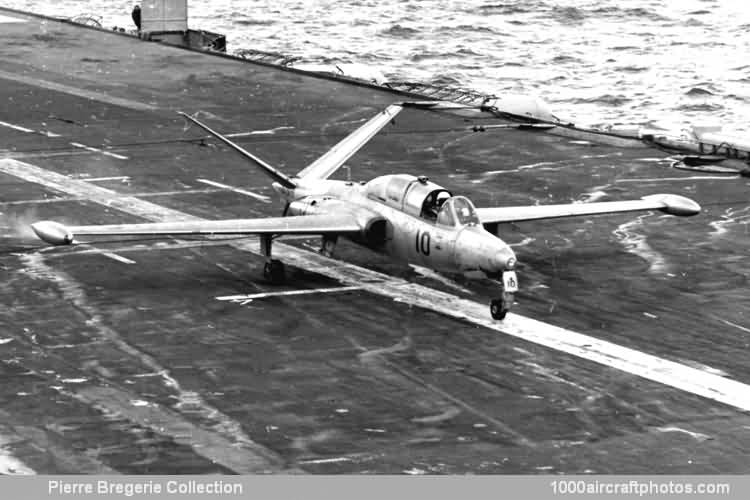The Zéphyr (formerly Esquif) was a naval trainer version of the Magister, and two prototypes and thirty production aircraft were built for the French Navy. These were used for specialized training in air fighting, blind flying instruction, missile firing practice and training in deck landing. The first prototype flew for the first time on July 31, 1956, and underwent simulated deck-landing trials at the RAE Bedford, UK, later in that year. Both prototypes subsequently completed full-scale deck trials on HMS Bulwark and Eagle. The first production Zéphyr flew on May 30, 1959.
The Zéphyr was generally similar to the Magister but incorporated certain modifications to meet naval requirements. These included catapult hook and hold-back strop, arrester hook and two separate rearward-sliding hoods in place of the upward-hinged canopies of the Magister to permit catapulting with cockpits open. The strengthened Messier landing gear was 6 in (0.15 m) longer than on the Magister but was compressed during retraction so that the wheel wells did not to have to be modified."
Type: Light twin-jet carrier-based trainer.
Wings: Mid-wing cantilever monoplane. NACA 64 Series wing section, thickness/chord ratio varying from 19% at root to 12% at tip. Aspect ratio: 7.42. Chord 6 ft 6 in (1.98 m) at root, 2 ft 10 in (0.87 m) at tip. Taper ratio 0.40. No dihedral. Incidence 2°. leading edge sweepback 13°, trailing edge sweep-back nil. Single-spar structure with aluminum-alloy stressed skin. Hydraulically-operated all-metal slotted high-lift flaps of area-increasing type. Initially automatic tabs in ailerons, later production aircraft servo-control ailerons. Retractable air brakes in upper and lower surfaces. Wings did not fold. Total flap area 22.6 sq.ft (2.10 sq.m). Total aileron area 11.84 sq.ft (1.10 sq.m). Gross wing area 186.1 sq.ft (17.30 sq.m).
Fuselage: Oval all-metal semi-monocoque stressed-skin structure.
Tail unit: Butterfly type, the two tapered surfaces formed an inner angle of 110°. All-metal single-spar structure. Statically and aerodynamically balanced elevators. Projected areas: horizontal 40 sq.ft (3,71 sq.m), vertical 28 sq.ft (2.60 sq.m). Span of tail 14 ft 41 in (4.38 m).
Landing gear: Messier retractable nose wheel type with long-stroke Messier oleo-pneumatic shock-absorbers compressed during retraction. Hydraulic actuation. Nose wheel had anti-shimmy device. Kleber Colombe 10HP wheels and Dunlop 04 tires. Messier hydraulic brakes. Wheel base 15 ft 5 in (4.70 m). Wheel track 12 ft 6.75 in (3.80 m). Maximum catapult acceleration 4G, maximum arrester gear deceleration 4.5G.
Power plant: Two 880 lb (400 kg) st Turboméca Marboré IIB turbojet engines. Main fuel in two fuselage tanks of 62 gal (235 l) and 125.5 gal (475 l) capacity respectively. Total internal fuel capacity 187.5 (710 l). Two fixed wing tip tanks (33 gal, 125 l each) may be fitted. Oil capacity 6.45 gal (24.4 l).
Accommodation: Tandem cockpits under continuous transparent canopy. Separate rearward-sliding canopy over each seat. Pupil in front seat, instructor in rear. All flying and engine controls duplicated, but controls for emergency landing gear release, flaps, air-brakes, brakes and arrester hook in front cockpit only. Cockpits were pressurized and air-conditioned by SEMCA turbo-refrigeration equipment driven by air bleeds from engine compressors. Individual oxygen supply with regulator in each cockpit. VHF radio, SFR radio compass and inter-phone equipment. Blind-flying equipment.
Armament: Two 0.295 in (7.5 mm) machine guns (200 rpg) in fuselage nose. Gyro gun-sight in each cockpit, in rear cockpit fitted with additional periscopic sight. Racks for four 55 lb (25 kg) air-to-ground rockets, two 110 lb (50 kg) bombs or one Nord S.S.l1 guided missile could be fitted under each wing.
